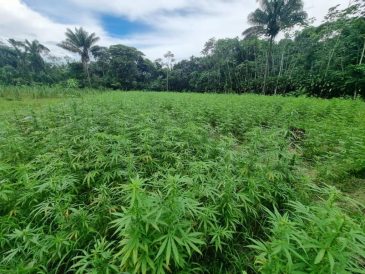First Published: 18th of October, 2021. Guyana, South America
Last updated: April 26, 2023 at 17:47 pmThe question as to why Guyana stopped (generally) utilizing clay bricks in construction is hard to answer. Whether it was a dirty political move or shortsighted business decision is left only to speculation. But one thing is certain: the idea of reviving Guyana’s clay brick industry needs serious reconsideration.
Clay bricks are widely produced and utilized in the hinterland regions of Guyana where it is the material of choice for construction of homes. It is cheaper, more durable, and more aesthetically appealing than cement blocks. In colonial days, this locally produced construction material had been the building blocks of the vast majority of concrete structures. So why then were clay bricks sidelined in favor of the inferior cement blocks made from imported cement? And why are the heavy lifters in Guyana’s construction industries preferring cement blocks over clay bricks?
The whole scenario reeks of an unpatriotic spirit, a “don’t care a damn” attitude, and a sell-off to Trinidadian Companies which keep pushing cement and by extension, cement blocks, on the Guyanese market – with little to no thought of how this would weaken the Guyanese economy (and infrastructure as well), and the thousands of unemployed Guyanese who can easily make a healthy living while strengthening Guyana’s economy (and infrastructure) through clay brick production right here in Guyana.
What consistently seems to elude the government of the day in Guyana is the merits and benefits of utilizing clay bricks instead of concrete blocks in construction across the country. The more we make use of our natural, God-given resources, the richer Guyana becomes since this will cause our country’s GDP to go up. If Guyana produces more clay bricks instead of buying cement blocks, more local people will be employed and more money gets circulated into Guyana’s economy. This may also help to curb crime by providing more opportunities for meaningful employment.
In the year 2019, a Chronicle News Article reported that clay bricks purchased from the North Rupununi reduced the construction cost of low-income homes by 25%, and that the Central and Housing Planning Authority was at that time exploring the possibility of utilizing clay bricks more extensively.
“The houses built with the bricks are much cheaper and we recognize that. For example, if we are looking at the starter homes constructed that are 400 square feet, using the concrete blocks the building would cost us around $4 million but using the clay blocks it costs us about $3 million, you can see that it’s much cheaper,” Saul explained.
Read story
The clay brick industry in Guyana by no means derives its merits from boycotting Trinidadian industries, nor does it seek to blow cement and cement blocks completely out of the water. But what it will do though, is give the cement block a good run for its money on the basis of the superiority of clay bricks over cement blocks, and the fact that producing them locally will strengthen Guyana’s economy.
It is important to note that there are some things we as a country can produce and some we can’t. No country can thrive without imports – especially not a small country like Guyana. You’ve heard the saying that “no man is an island.” On the same note, “no country is a planet.” We all rely on each other, and what we can’t produce we must import. Imports and exports make the world go ’round.
On the other hand, there are some things we can produce cheaply in our own country, and which we have the competitive edge to produce. And one of these is clay bricks.
Here are some fun facts about clay bricks:
- They are stronger than cement blocks.
- They last longer than cement blocks.
- They reduce construction costs (in Guyana)
- They’re more beautiful than cement blocks.
- They strengthen Guyana’s economy.
- They utilize Guyana’s natural resources.
In addition, machines can be sourced from China which can be run on solar energy and churn out hundreds of clay-bricks per minute.
In light of all of the above, it would clearly be beneficial to the people of Guyana if the Government of Guyana gives more financial and marketing support to Guyanese seeking to develop the country’s potentially vast and wildly profitable clay bricks industry.
The photos below show some beautiful houses made of clay bricks in Lethem, Region 9. Clay bricks are superior to concrete blocks in so many ways. In addition, it harnesses a resource we have abundantly under our feet.
These clay bricks were imported from neighboring Brazil. The owner of these houses, Mr. Clavis Nicholson, explained to this publication that although clay brick is being produced in Region 9, the quality is lower, and so he had to import from Brazil for this project.
Isn’t it time Guyana revives its floundering clay brick industry and create jobs for so many citizens, wealth for the country and beautiful buildings too? I’m sure that with a little more training, determination, and equipment Guyanese too can produce industry standard clay bricks for the whole country!


























White sand is cheap and easily available. Blocks can be made at the site with a simple mold.
Clay bricks need clay and energy to bake it in a controlled environment.
clay bricks may be not be cheaper. You need to crunch numbers if you write about this topic.
I agree with the comments above. I do not remember the size of the concrete blocks used in Guyana but they were bigger than clay blocks and can be laid much quicker and does nort reqire the same skill in laying.
Energy is also requred to produce cement.